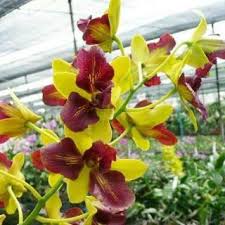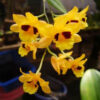# How to Create a Colorful Dendrobium Orchid Garden

Creating a colorful Dendrobium orchid garden can be a rewarding and fulfilling endeavor for both novice and experienced gardeners. Known for their striking blooms and vibrant colors, Dendrobium orchids are a popular choice among orchid enthusiasts. This guide will walk you through the steps to successfully cultivate a stunning garden filled with Dendrobium orchids, covering everything from selecting the right varieties to proper care and maintenance.
## 1. Introduction to Dendrobium Orchids
### 1.1 What are Dendrobium Orchids?
Dendrobium orchids are part of the Orchidaceae family and comprise over 1,800 species. They are native to tropical and subtropical regions of Asia, Australia, and the Pacific Islands. Known for their diverse colors and forms, these orchids can produce flowers in shades of white, pink, purple, yellow, and even green, making them an excellent choice for creating a vibrant garden.
### 1.2 Why Choose Dendrobium Orchids for Your Garden?
Dendrobium orchids are not only beautiful but also versatile. They can thrive in various environments, making them suitable for both indoor and outdoor gardens. Their blooms can last several weeks, providing continuous color throughout the growing season. Additionally, Dendrobium orchids are relatively easy to care for, making them an accessible choice for gardeners of all skill levels.
## 2. Planning Your Dendrobium Orchid Garden
### 2.1 Choosing the Right Location
When planning your Dendrobium orchid garden, the first step is to select the right location. Dendrobium orchids thrive in bright, indirect light. Here are some tips for choosing the perfect spot:
– **Light Exposure**: Look for a location that receives filtered sunlight for several hours a day. East or west-facing windows or shaded areas under trees can provide the ideal light conditions.
– **Temperature**: Dendrobium orchids prefer temperatures between 65°F and 85°F (18°C to 29°C) during the day and slightly cooler at night. Ensure the chosen spot does not experience extreme temperature fluctuations.
– **Humidity**: These orchids thrive in high humidity levels, ideally between 50% and 70%. Consider using a humidity tray or a small humidifier if your area is particularly dry.
### 2.2 Selecting Dendrobium Orchid Varieties
Choosing the right Dendrobium varieties is crucial for a colorful garden. Here are some popular varieties to consider:
– **Dendrobium nobile**: Known for its classic beauty, this variety produces clusters of fragrant flowers in shades of purple, pink, and white.
– **Dendrobium phalaenopsis**: This hybrid variety features large, flat flowers resembling moths, available in various colors, including white, yellow, and lavender.
– **Dendrobium kingianum**: A compact variety that blooms in clusters of fragrant flowers, typically in shades of purple or white, making it perfect for smaller gardens.
– **Dendrobium aggregatum**: This variety is known for its cascading clusters of yellow flowers, adding a cheerful touch to any garden.
By selecting a mix of these varieties, you can create a visually appealing garden that blooms at different times throughout the year.
## 3. Preparing the Soil
### 3.1 Choosing the Right Potting Medium
Dendrobium orchids prefer a well-draining potting medium that allows air circulation to their roots. Here are some suitable options:
– **Orchid Bark**: A popular choice for orchids, orchid bark provides excellent drainage and aeration.
– **Coconut Coir**: This sustainable option retains moisture while still allowing for good airflow.
– **Perlite and Sphagnum Moss Mix**: A combination of perlite and sphagnum moss offers both drainage and moisture retention, making it suitable for Dendrobium orchids.
### 3.2 Preparing the Soil
When preparing the soil for your Dendrobium orchids, consider the following steps:
1. **Choose a Pot**: Select pots with drainage holes to prevent water accumulation. Clay pots are a good choice as they allow for airflow.
2. **Mix Your Potting Medium**: Combine orchid bark, coconut coir, and perlite in a large container to create a well-draining mix. The ratio can vary, but a common mix is 60% bark, 30% coir, and 10% perlite.
3. **Moisten the Medium**: Before planting, lightly moisten the potting medium to facilitate root establishment.
## 4. Planting Dendrobium Orchids
### 4.1 Timing Your Planting
The best time to plant Dendrobium orchids is during their growing season, which typically occurs in spring. This timing allows the orchids to establish roots and adapt to their new environment.
### 4.2 Planting Steps
Follow these steps to plant your Dendrobium orchids:
1. **Remove the Orchid from Its Container**: Gently remove the orchid from its original container, taking care not to damage the roots.
2. **Trim Damaged Roots**: Inspect the roots and trim any damaged or dead roots with sterilized scissors.
3. **Position the Orchid in the Pot**: Place the orchid in the center of the new pot, ensuring that the roots are spread out and not overcrowded.
4. **Fill with Potting Medium**: Add the prepared potting medium around the roots, gently pressing it down to eliminate air pockets. Leave the top of the roots exposed for optimal airflow.
5. **Water the Orchid**: After planting, give the orchid a good watering to help settle the medium around the roots.
## 5. Caring for Your Dendrobium Orchid Garden
### 5.1 Watering
Proper watering is crucial for the health of your Dendrobium orchids. Here are some tips:
– **Watering Frequency**: Water your orchids once every 1 to 2 weeks, allowing the potting medium to dry slightly between waterings.
– **Watering Method**: Water thoroughly, allowing excess water to drain out of the bottom of the pot. Avoid letting the orchid sit in standing water, as this can lead to root rot.
### 5.2 Fertilizing
Dendrobium orchids benefit from regular feeding during the growing season. Here’s how to fertilize effectively:
– **Type of Fertilizer**: Use a balanced orchid fertilizer with an N-P-K ratio of 30-10-10 or 20-20-20, diluted to half-strength.
– **Fertilizing Schedule**: Fertilize every 2 to 4 weeks during the growing season (spring and summer) and reduce to once a month during the dormant season (fall and winter).
### 5.3 Pruning and Repotting
Regular pruning and repotting are essential for maintaining healthy Dendrobium orchids:
– **Pruning**: Remove any dead or yellowing leaves to promote airflow and prevent disease. Cut spent flower spikes back to the base after blooming.
– **Repotting**: Repot your orchids every 1 to 2 years, or when the potting medium breaks down. This ensures proper drainage and provides fresh nutrients.
## 6. Managing Pests and Diseases
### 6.1 Common Pests
Dendrobium orchids can be susceptible to pests such as aphids, mealybugs, and spider mites. Here’s how to manage them:
– **Regular Inspections**: Check your orchids regularly for signs of pests. Look for sticky residue, webbing, or discoloration.
– **Natural Remedies**: Use insecticidal soap or neem oil to treat pest infestations. Apply according to the manufacturer’s instructions.
### 6.2 Preventing Diseases
Preventing diseases is crucial for the health of your Dendrobium orchids:
– **Avoid Overwatering**: Overwatering can lead to root rot. Ensure proper drainage and allow the potting medium to dry between waterings.
– **Good Air Circulation**: Provide adequate spacing between plants to promote airflow and reduce humidity levels that can encourage fungal diseases.
## 7. Creating a Colorful Display
### 7.1 Arranging Your Dendrobium Orchids
To create a vibrant display, consider the following tips for arranging your Dendrobium orchids:
– **Color Coordination**: Choose orchids with complementary colors to create a harmonious look. For example, pair purple Dendrobium nobile with yellow Dendrobium aggregatum for a striking contrast.
– **Varying Heights**: Use pots of different heights to create visual interest. Taller orchids can be placed at the back, with shorter varieties in front.
– **Grouping**: Group orchids in clusters to create a more dynamic display. This can enhance the overall impact and make the colors pop.
### 7.2 Incorporating Other Plants
Consider incorporating other plants into your Dendrobium orchid garden for added texture and variety. Here are some ideas:
– **Foliage Plants**: Add plants with lush foliage, such as ferns or peace lilies, to provide a contrasting backdrop to your orchids.
– **Companion Plants**: Choose companion plants that thrive in similar conditions, such as Phalaenopsis orchids or other tropical plants, to enhance the garden’s diversity.
## 8. Seasonal Care
### 8.1 Summer Care
During the summer months, ensure your Dendrobium orchids receive sufficient light and water. Be mindful of the increased temperatures, as they may require more frequent watering.
### 8.2 Winter Care
In winter, reduce watering frequency and avoid fertilizing. Ensure your orchids are protected from cold drafts, and consider moving them indoors if necessary.
## 9. Conclusion
Creating a colorful Dendrobium orchid garden is a fulfilling project that can bring beauty and vibrancy to your outdoor or indoor
space. By choosing the right location, selecting a variety of orchids, and providing proper care, you can cultivate a stunning display of these exquisite flowers. With patience and dedication, your Dendrobium orchid garden will thrive, rewarding you with vibrant blooms for years to come. Embrace the journey of gardening and enjoy the enchanting beauty of Dendrobium orchids as they flourish in your care.

